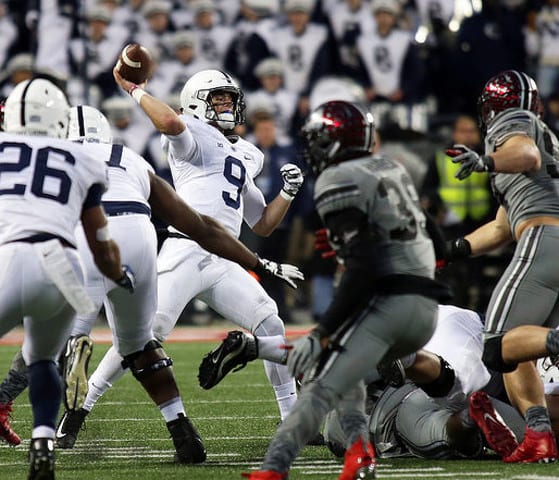Take it from Trace McSorley — accounting major, Academic All-Big Ten and Penn State quarterback.
Every. Play. Counts.
That was his manta after the 1,965 plays that were the Nittany Lions’ 10-2 regular season in 2017.
‘There are so many plays that can be the difference,’ McSorley said after Penn State’s 66-3 regular-season finale over Maryland.
‘You have to treat each play like, ‘This play right here is going to win the game.’ ‘
That was the case the evening of Sept. 23 in Iowa City, when Penn State defeated the Hawkeyes 21-19 on the game’s final play in Kinnick Stadium.
Penn State’s offense ran 99 plays that night, including an astounding 30 in the fourth quarter alone (plus three penalties). Yet it was the final play, a 7-yard floater from McSorley to Juwan Johnson on a makeshift play, that ended up with three Penn State receivers bunched together like they were on a phone booth that made the final difference.
Every play counts.
And that was the case in successive weeks at Columbus (Oct. 28) and East Landing (Nov. 4), when the Buckeyes won on their final offensive play and Sparty won on a game-ending field goal. If the Nittany Lion defense had held just one of Ohio State’s 21 fourth-quarter plays, Penn State might be in the College Football Playoff. Same goes for a penalty here and an incomplete pass there in the final minutes in the perfect storm in East Lansing.
Close, but no McSorgar.
SAGE ADVICE
Those are the lessons that Trace — who has thrown 813 passes and run 291 times as a PSU QB — takes with him into the postseason and 2018.
‘Looking back at those two games, there are plays you want to have back,’ McSorley said. ‘The losses are so close. Two losses by four points. They were such close games that there are plays in there that we could have made on offense or defense.’
Literally, a play or a two and Penn State could be prepping for New Orleans or a return trip to Pasadena, instead of Glendale, Arizona.
In all, Penn State was on the offensive for 985 plays in 2017 — 413 runs, 417 passers, 52 punts, 16 field goal attempts and 87 kickoffs.
Their opponents accounted for 980 — 423 runs, 420 passes, 82 punts, 13 field goal attempts and 42 kickoffs.
So, Penn State’s offense, its defense and all special team units had near-equal opportunities to make just one more play.
‘The learning experience is that you don’t get the opportunity to go back and fix it,’ McSorley said. ‘You need to treat every play like gold. You have to play like it’s gold during the game. You never know which one is going to be the difference.’
As it was, the Nittany Lions played 720 minutes of football in 2017 and trailed for just 48 minutes and 27 seconds — 3,007 seconds. Total.
A good (or bad) bit of that was against Rutgers. Against the Scarlet Knights, Penn State trailed for 20:28. Against Michigan State, they were behind for 11:29; against Nebraska, for 9:24; and against Ohio State, for 1:48.
They would be Penn State’s final 108 seconds in The Horseshoe. That was Penn State’s worst quarter of football in 2017. They were outscored by the Buckeyes, 19-3, and outgained 182 yards to 64 (although OSU ran 12 times for just 8 yards).
One play coulda, woulda, shoulda made a difference.
IN THE FISH BOWL
That’s Penn State head coach James Franklin’s mantra as well.
‘We talk to players about staying in the moment,’ Franklin once said. ‘We want our guys to take it one play at a time — give me everything you’ve got for six seconds. Take it one play at a time, day at a time, class at a time, game at a time.’
This is what Franklin means: The average play in college football lasts all of six seconds. He’s not asking for a lot. After all, the attention span of a gold fish lasts nine seconds. True — click here.
Given that Penn State averaged 165 plays per game in 2017 — offense, defense, special teams — that means there was only 16-and-half minutes of real action in a 60-minute game.
So it makes sense that when you ask a sports scientist what the most important measurable is in college football, the answer is swift and sure: A player’s ability to explode off the line of scrimmage or with his first few steps out of the backfield. To hell with the 40, the 4 is the most important measurable.
SHORT AND BITTERSWEET
Football is a game of bursts. With explosive plays. That you win by making your own breaks. Six seconds at a time.
Like Grant Haley’s scoop-and-score against Ohio State.
And that backyard TD pass against Iowa.
And, over those eight days in the heart(less) of this past autumn, a few final and ultimately fatal plays ended up defining Penn State’s 2017 season.
‘They made the plays when they needed to and we didn’t,’ McSorley said after that 39-38 lossx to Ohio State. ‘That goes hand in hand.’



